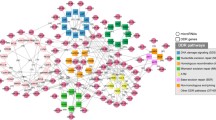Abstract
It is known that microRNAs (miRNAs) expression profile shows substantial changes in cells under DNA damage. Here, we did miRNA microarray and quantitative real-time PCR to comprehensively identify the differentially expressed miRNAs in colon cancer cell lines HCT116 p53+/+ and HCT116 p53−/−. Cluster analysis revealed a panel of differentially expressed miRNAs which are regulated by p53 and/or UV-C induced DNA damage. These altered miRNAs tend to be located in chromosomes 13, X and 17. Moreover, pathways enrichment analysis estimated that MAPK pathway, focal adheren pathway, p53 pathway and Wnt pathway were mediated by these miRNAs to exert their functions in DNA damage response. Additionally, we found that miR-320a, one of the UV-C induced miRNAs, play a role in protecting cells from DNA damage. Taken together, our results show that miRNAs are dynamic regulated in p53-dependent or -independent manners in different cell contexts and different situations following DNA damage.





Similar content being viewed by others
References
Bartel DP (2009) MicroRNAs: target recognition and regulatory functions. Cell 136:215–233
Bohlig L, Friedrich M, Engeland K (2011) p53 activates the PANK1/miRNA-107 gene leading to downregulation of CDK6 and p130 cell cycle proteins. Nucleic Acids Res 39:440–453
Boominathan L (2010) The tumor suppressors p53, p63, and p73 are regulators of microRNA processing complex. PLoS One 5:e10615
Bronisz A, Godlewski J, Wallace JA et al (2012) Reprogramming of the tumour microenvironment by stromal PTEN-regulated miR-320. Nat Cell Biol 14:159–167
Ciccia A, Elledge SJ (2010) The DNA damage response: making it safe to play with knives. Mol Cell 40:179–204
Gentile M, Latonen L, Laiho M (2003) Cell cycle arrest and apoptosis provoked by UV radiation-induced DNA damage are transcriptionally highly divergent responses. Nucleic Acids Res 31:4779–4790
Harper JW, Elledge SJ (2007) The DNA damage response: ten years after. Mol Cell 28:739–745
He L, He X, Lim LP et al (2007) A microRNA component of the p53 tumour suppressor network. Nature 447:1130–1134
Hermeking H (2012) MicroRNAs in the p53 network: micromanagement of tumour suppression. Nat Rev Cancer 12:613–626
Hoh J, Jin S, Parrado T et al (2002) The p53MH algorithm and its application in detecting p53-responsive genes. Proc Natl Acad Sci USA 99:8467–8472
Hsieh IS, Chang KC, Tsai YT et al (2013) MicroRNA-320 suppresses the stem cell-like characteristics of prostate cancer cells by downregulating the Wnt/beta-catenin signaling pathway. Carcinogenesis 34:530–538
Hu H, Gatti RA (2011) MicroRNAs: new players in the DNA damage response. J Mol Cell Biol 3:151–158
Johnson CD, Esquela-Kerscher A, Stefani G et al (2007) The let-7 microRNA represses cell proliferation pathways in human cells. Cancer Res 67:7713–7722
Kyriakis JM, Avruch J (2012) Mammalian MAPK signal transduction pathways activated by stress and inflammation: a 10-year update. Physiol Rev 92:689–737
Lakin ND, Jackson SP (1999) Regulation of p53 in response to DNA damage. Oncogene 18:7644–7655
Leung AK, Sharp PA (2010) MicroRNA functions in stress responses. Mol Cell 40:205–215
Leveille N, Elkon R, Davalos V et al (2011) Selective inhibition of microRNA accessibility by RBM38 is required for p53 activity. Nat Commun 2:513
Lindahl T, Barnes DE (2000) Repair of endogenous DNA damage. Cold Spring Harb Symp Quant Biol 65:127–133
Lu TP, Lee CY, Tsai MH et al (2012) miRSystem: an integrated system for characterizing enriched functions and pathways of microRNA targets. PLoS One 7:e42390
Manke IA, Nguyen A, Lim D et al (2005) MAPKAP kinase-2 is a Cell cycle checkpoint kinase that regulates the G2M transition and S phase progression in response to UV irradiation. Mol Cell 17:37–48
Roche KC, Rocha S, Bracken CP et al (2007) Regulation of ATR-dependent pathways by the FHA domain containing protein SNIP1. Oncogene 26:4523–4530
Rodriguez A, Griffiths-Jones S, Ashurst JL et al (2004) Identification of mammalian microRNA host genes and transcription units. Genome Res 14:1902–1910
Schaar DG, Medina DJ, Moore DF et al (2009) miR-320 targets transferrin receptor 1 (CD71) and inhibits cell proliferation. Exp Hematol 37:245–255
Seker H, Rubbi C, Linke SP et al (2003) UV-C-induced DNA damage leads to p53-dependent nuclear trafficking of PML. Oncogene 22:1620–1628
Shimono Y, Zabala M, Cho RW et al (2009) Downregulation of miRNA-200c links breast cancer stem cells with normal stem cells. Cell 138:592–603
Smith RA, Brooks D, Cokkinides V et al (2013) Cancer screening in the United States, 2013: a review of current American Cancer Society guidelines, current issues in cancer screening, and new guidance on cervical cancer screening and lung cancer screening. CA Cancer J Clin 63:88–105
Sun JY, Huang Y, Li JP et al (2012) MicroRNA-320a suppresses human colon cancer cell proliferation by directly targeting beta-catenin. Biochem Biophys Res Commun 420:787–792
Suzuki HI, Yamagata K, Sugimoto K et al (2009) Modulation of microRNA processing by p53. Nature 460:529–533
Trabucchi M, Briata P, Garcia-Mayoral M et al (2009) The RNA-binding protein KSRP promotes the biogenesis of a subset of microRNAs. Nature 459:1010–1014
Wu CW, Dong YJ, Liang QY et al (2013) MicroRNA-18a attenuates DNA damage repair through suppressing the expression of ataxia telangiectasia mutated in colorectal cancer. PLoS One 8:e57036
Xu N, Papagiannakopoulos T, Pan G et al (2009) MicroRNA-145 regulates OCT4, SOX2, and KLF4 and represses pluripotency in human embryonic stem cells. Cell 137:647–658
Acknowledgements
This work was supported by the National Natural Science Foundation of China (81021061). We appreciated Xuefeng Liu, Yunwei Ou and Jia Li for revising this manuscript and offering constructive advices.
Conflict of interests
The authors declare no conflict of interest.
Author information
Authors and Affiliations
Corresponding author
Additional information
SPECIAL TOPIC: MicroRNA and Tumor
Electronic supplementary material
Below is the link to the electronic supplementary material.
About this article
Cite this article
Zhang, W., Yang, F. & Zhan, Q. Dynamic analysis of DNA damage induced miRNAs in colon cancer cells. Chin. Sci. Bull. 59, 2254–2265 (2014). https://doi.org/10.1007/s11434-014-0331-5
Received:
Accepted:
Published:
Issue Date:
DOI: https://doi.org/10.1007/s11434-014-0331-5




